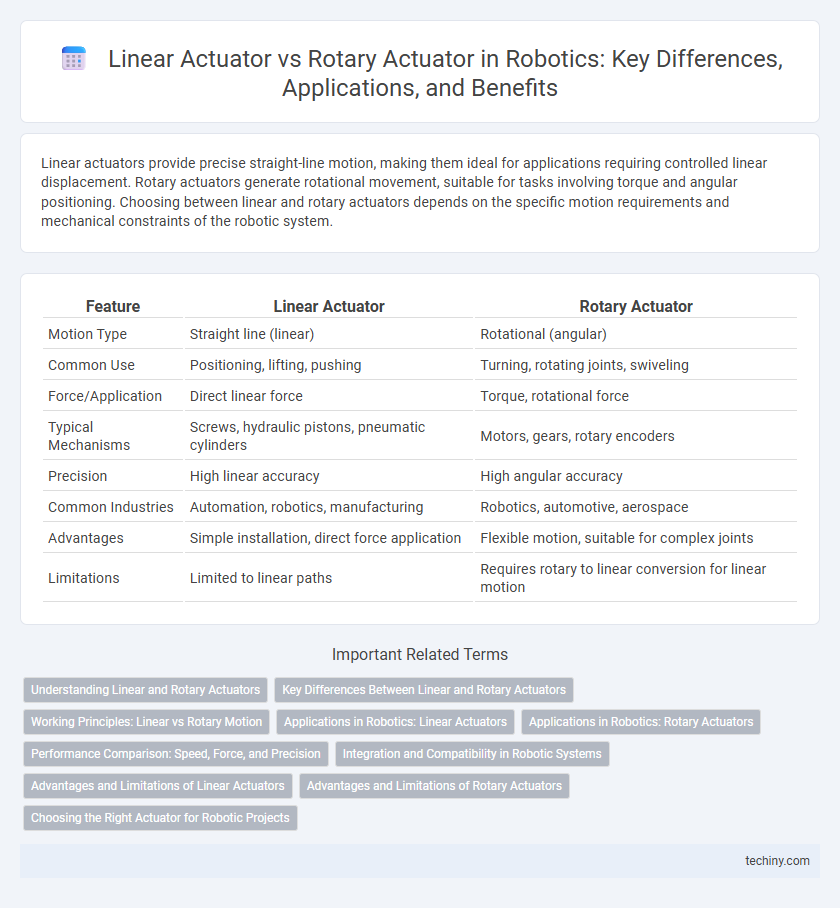Linear actuators provide precise straight-line motion, making them ideal for applications requiring controlled linear displacement. Rotary actuators generate rotational movement, suitable for tasks involving torque and angular positioning. Choosing between linear and rotary actuators depends on the specific motion requirements and mechanical constraints of the robotic system.
Table of Comparison
| Feature | Linear Actuator | Rotary Actuator |
|---|---|---|
| Motion Type | Straight line (linear) | Rotational (angular) |
| Common Use | Positioning, lifting, pushing | Turning, rotating joints, swiveling |
| Force/Application | Direct linear force | Torque, rotational force |
| Typical Mechanisms | Screws, hydraulic pistons, pneumatic cylinders | Motors, gears, rotary encoders |
| Precision | High linear accuracy | High angular accuracy |
| Common Industries | Automation, robotics, manufacturing | Robotics, automotive, aerospace |
| Advantages | Simple installation, direct force application | Flexible motion, suitable for complex joints |
| Limitations | Limited to linear paths | Requires rotary to linear conversion for linear motion |
Understanding Linear and Rotary Actuators
Linear and rotary actuators convert energy into controlled motion, with linear actuators producing straight-line movement and rotary actuators generating rotational motion. Linear actuators are essential in applications requiring precise linear displacement, such as robotic arms and manufacturing automation. Rotary actuators excel in tasks involving angular positioning and continuous rotation, widely used in robotic joints and rotary table systems.
Key Differences Between Linear and Rotary Actuators
Linear actuators convert energy into straight-line motion, ideal for applications requiring precise linear displacement such as robotic arms and sliding mechanisms. Rotary actuators produce rotational motion, suited for tasks involving turning, positioning, or continuous rotation, commonly used in robotic joints and wheels. Key differences include motion type--linear versus rotational--control complexity, speed, and torque, where linear actuators excel in direct push-pull actions while rotary actuators offer easier integration with gear systems for torque amplification.
Working Principles: Linear vs Rotary Motion
Linear actuators convert energy into straight-line motion by extending or retracting a piston or rod, ideal for applications requiring precise pushing or pulling actions. Rotary actuators transform energy into rotational motion, rotating an object around a fixed axis to achieve angular displacement. Understanding these working principles is crucial for selecting the appropriate actuator type based on motion requirements in robotic systems.
Applications in Robotics: Linear Actuators
Linear actuators play a crucial role in robotics by providing precise, controlled linear motion essential for tasks such as lifting, pushing, or positioning components. Common applications include robotic arms, grippers, and automated assembly lines where accurate straight-line movement enhances operational efficiency. Their ability to convert rotational motion into linear displacement makes them indispensable for handling repetitive or heavy-duty robotic functions.
Applications in Robotics: Rotary Actuators
Rotary actuators are essential in robotics for applications requiring precise angular motion, such as robotic arms, grippers, and joint rotations. Their ability to deliver continuous rotation or controlled angular displacement makes them ideal for tasks involving articulation, positioning, and manipulation. Industries like automotive manufacturing, aerospace, and medical robotics heavily rely on rotary actuators for high torque and accurate movement control.
Performance Comparison: Speed, Force, and Precision
Linear actuators deliver direct motion with high force and precise positioning, ideal for applications requiring straight-line movement. Rotary actuators excel in speed and continuous rotation, offering smooth torque output critical for tasks needing angular displacement. Performance differences hinge on application demands: linear actuators achieve superior force and positional accuracy, while rotary actuators provide faster rotational speed and efficient torque control.
Integration and Compatibility in Robotic Systems
Linear actuators offer straightforward integration in robotic systems requiring precise linear motion, benefiting from simpler control algorithms and direct compatibility with linear guides. Rotary actuators excel in applications demanding rotational movement, providing versatile mounting options and seamless integration with rotary joints and gears common in robotic arms. Choosing between linear and rotary actuators hinges on the specific kinematic requirements and existing mechanical interfaces within the robotic system.
Advantages and Limitations of Linear Actuators
Linear actuators provide precise straight-line motion essential for applications requiring high accuracy and repeatability in robotics, such as pick-and-place tasks or CNC machinery. Their advantages include simpler control systems, direct translation of electrical input to linear displacement, and a compact design that fits into tight spaces. However, limitations arise in speed and range of motion compared to rotary actuators, as well as increased wear on mechanical components due to linear friction and potential need for higher maintenance.
Advantages and Limitations of Rotary Actuators
Rotary actuators offer precise angular positioning and higher torque capabilities, making them ideal for applications requiring rotational motion such as robotic arms and joint movements. Their compact design allows integration into confined spaces, but they may suffer from limited rotation angles compared to linear actuators and can experience backlash or reduced accuracy in high-load conditions. Maintenance complexity and higher cost are additional limitations, especially in environments with continuous or heavy-duty operation.
Choosing the Right Actuator for Robotic Projects
Linear actuators provide precise straight-line motion essential for tasks requiring accurate positioning, such as robotic arms and grippers, while rotary actuators excel in applications needing rotational movement like wheel drives or joint rotations. Selecting the right actuator depends on the specific motion requirements, load capacity, and space constraints of the robotic project. Evaluating factors such as speed, force output, and integration complexity ensures optimal performance and efficiency in robotic systems.
Linear actuator vs rotary actuator Infographic

 techiny.com
techiny.com